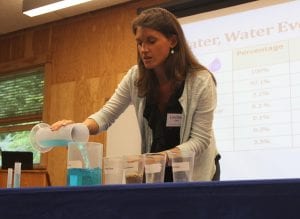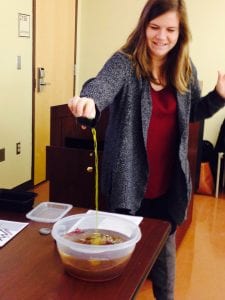Thirsty for more SDG lesson plans as summer fast approaches? This blog post will focus on Sustainable Development Goal 6, and two lessons that address water use and management in the face of our growing population.
SDG 6 states that all participating nations will ensure availability and sustainable management of water and sanitation for all. Today’s lessons Water, Water Everywhere, and Who Polluted the Potomac? spotlight water availability and use on our blue planet. Read on for more information!

1) Water, Water Everywhere – This lesson actually comes in two versions – one for middle/high school grades, and one for elementary. In the activity, students reflect on how, despite the seeming abundance of water on our planet, only a very small fraction of Earth’s total water is freshwater readily available for human consumption. For science teachers who are interested in linking more standards, this lesson is also tied to NGSS.
Content areas: Conducting this lesson will meet content standards in:
Environmental Science, Math, Social Studies
Skills: Through this lesson, students will be able to:
-Differentiate between the different types of water available on our planet
-Understand aspects of a shared natural resource, such as availability and distribution.
-Estimate the amount of resources they use and compare that figure to actual use.
-Design a graph to show current resource use and use after conservation measures have been taken.
Learning strategies: This lesson utilizes multiple learning styles including:
Estimation, graphing, mathematics calculation, observation, research, writing

2) Who Polluted the Potomac? – This is one of our most popular lessons. Students participate in an interactive story describing the history of the Potomac River and the city that grew along its banks. The teacher will read aloud from the provided text, and students will play characters who contribute pollutants and other products to the river as the population grows over time. Together, students will investigate how actions we may believe only impact ourselves, might actually have deeper or indirect consequences.
Like Water, Water, Everywhere, this lesson has versions suitable for lower elementary, middle grades, and high-school aged students.
*The lower elementary version is called Who Polluted the River? The lesson plan includes a shorter, simpler interactive story text and fewer characters. We also provide character nametags and cards, and suggest a modification wherein you can add a ‘fish’ to the river to more specifically demonstrate how pollution affects wildlife.
*The high school version is called Code Blue: Endangered Oceans and focuses on ocean health, how global population growth has an effect on natural resources, and the difficulties of managing an international commodity. This lesson plan includes a more complex, interactive story which features more characters and deeper descriptions of the chemical and physical interactions resulting from population growth and increased pollution. Topics discussed include: oil spills, ocean acidification, coral bleaching, and more.
Content areas: Conducting this lesson will meet content standards in:
Environmental Science and Biology, Social Studies, Language Arts, Geography, Health, History, Economics, Civics
Skills: Through this lesson, students will be able to:
-List the principal pollutants in our waterways and water resources
-Draw connections between individual actions and results at the community level
-Link population growth and dynamics and its subsequent impact on pollution of shared resources
-Develop strategies for minimizing and counteracting environmental problems
-Identify local services associated with waste management
Learning strategies: This lesson utilizes multiple learning styles including:
Critical thinking, listening and observing, role playing, understanding cause and effect
Thanks for reading this post! For information on other SDG lessons, check out the Population Education SDG Series Home.


